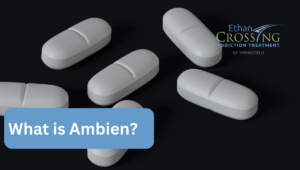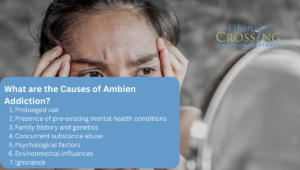Ambien addiction happens when an individual develops a reliance on the medication Ambien. They persistently take it despite the adverse effects it causes them both physically and emotionally. Ambien falls under the category of sedative-hypnotics, exerting a calming and relaxing impact on the brain, which some individuals find appealing, prompting continued misuse.
The onset of Ambien addiction often happens when individuals start depending on the medication for sleep and gradually develop both psychological and physical dependencies. They may struggle to achieve restful sleep without the drug, and over time, the initial therapeutic benefits may diminish, prompting an escalation in dosage. This sets in motion a cycle marked by dependence, tolerance, and an increasing pattern of usage.
Possible causes of Ambien addiction include prolonged use, genetics, and possibly other underlying mental conditions. Treatment of Ambien addiction is a multifaceted process that involves the use of physical therapy and forms of treatment.
Table of Contents
What is Ambien?
Ambien, also known as Zolpidem is a drug that falls within the category of sedative-hypnotics, specifically a non-benzodiazepine “Z-Drug.” This medication activates the neurotransmitter γ-Aminobutyric acid (GABA), inducing a slowdown in both the brain and the central nervous system (CNS). Primarily it is prescribed for insomnia. Webmd.com recommends short-term usage due to the risk of addiction it carries. It is available in two forms:
- a quick-release variant aiding sleep initiation
- an extended-release version supporting sleep maintenance.
Ambien was originally developed as a less addictive alternative to Benzodiazepines like Xanax. Ambien was intended to provide similar medical effectiveness without the same hazardous and habit-forming properties. Despite this, there is evidence that Ambien is addictive and can cause dependence in users. In 2007, Victorri-Vigneau C., et al. published an article “Evidence of zolpidem abuse and dependence: Results of the French Centre for Evaluation and Information on Pharmacodependence (CEIP) network survey” that proves there is risk of addiction associated with the use of Ambien.
Because of this risk, Ambien is classified as a Schedule IV controlled substance by the United States Drug Enforcement Administration (DEA). Beyond typical side effects, individuals may experience euphoria, and some misuse Ambien for its potential to induce feelings of euphoria and hallucinations.
What are the Symptoms of Ambien Addiction?
The signs and symptoms of Ambien addiction encompass various aspects, ranging from physical and psychological to behavioral and social indicators. Common manifestations associated with Ambien addiction include:
- Increased Tolerance to Ambien: Needing higher doses to achieve the same effects.
- Dependence on Ambien to Function or Sleep: Reliance on the drug for daily functioning or sleep initiation.
- Withdrawal Symptoms: Experiencing negative effects when attempting to reduce or stop Ambien use.
- Compulsive or Uncontrollable Use: Difficulty controlling the frequency and amount of Ambien consumed.
- Persistent Use Despite Negative Consequences: Continuing to use Ambien despite awareness of detrimental effects.
- Neglecting Responsibilities: Failing to fulfill duties and obligations due to Ambien use.
- Social Withdrawal or Isolation: Pulling away from social interactions.
- Doctor Shopping or Seeking Multiple Prescriptions: Attempting to obtain Ambien from multiple sources.
- Continued Use Despite Negative Health Effects: Ignoring adverse health impacts linked to Ambien use.
- Loss of Interest in Enjoyable Activities: Diminished enthusiasm for previously enjoyed activities.
- Preoccupation with Obtaining and Using Ambien: Persistent focus on acquiring and using the drug.
- Spending Significant Time and Effort on Ambien: Devoting substantial resources to obtaining Ambien.
- Financial Difficulties: Facing monetary challenges due to Ambien use.
- Relationship Problems: Strained relationships attributed to Ambien use.
- Neglect of Personal Hygiene: Disregarding personal care and hygiene.
- Changes in Sleep Patterns: Deviations from normal sleep patterns beyond the intended use of Ambien.
- Mood Swings and Emotional Instability: Fluctuations in emotions and mood.
- Secretive Behavior: Hiding Ambien use from others.
- Failed Attempts to Quit or Cut Down: Inability to reduce or cease Ambien use despite attempts.
- Engaging in Risky Behaviors: Participating in hazardous activities while under the influence of Ambien.
Individual experiences may vary based on addiction severity, genetic factors, and other physical and psychological considerations.
What are the Causes of Ambien Addiction?
The development of Ambien addiction is multifactorial. It involves a combination of biological, psychological, and environmental influences. The causes of Ambien addiction include
- Prolonged use: Extended use of Ambien or the consumption of higher-than-prescribed doses can elevate the risk of addiction. Long-term usage may result in physical dependence, making it challenging to discontinue without encountering withdrawal symptoms. To avoid this, WebMD recommends not exceeding 10 milligrams daily for 7-14 days.
- Presence of pre-existing mental health conditions: Individuals with pre-existing mental health issues such as anxiety, depression, or insomnia may have an increased vulnerability to Ambien addiction. These issues might cause them to self-medicate on Ambien, thus heightening the risk of dependence and addiction.
- Family history and genetics: Genetic factors play a role in determining an individual’s susceptibility to addiction. A family history of substance abuse or addiction has been noted to contribute to an elevated risk of developing Ambien addiction.
- Concurrent substance abuse: Those with a history of substance abuse or addiction to other substances may be more predisposed to Ambien addiction. Concurrent use of Ambien with other substances can amplify the risk of addiction and potentially dangerous interactions.
- Psychological factors: Stress, trauma, or a history of addictive behaviors can be significant psychological contributors to Ambien addiction. Some individuals may turn to Ambien as a coping mechanism or to escape from emotional distress.
- Environmental influences: The surroundings in which an individual lives can impact the likelihood of Ambien addiction. A social circle that normalizes drug use or environments where Ambien is readily available may contribute to addiction.
- Ignorance: Insufficient knowledge about the potential risks and addictive nature of Ambien can lead to misuse or dependency. A lack of awareness regarding alternative coping strategies for sleep problems or limited access to appropriate healthcare may also contribute to Ambien addiction.
What are the Effects of Ambien Addiction
The effects of Ambien addiction are diverse and extend across various aspects of an individual’s life, impacting physical, psychological, social, and occupational well-being.
Physical Effects
Individuals grappling with Ambien addiction may develop tolerance. This results in them raising the doses to achieve the desired effects. Attempts to quit or reduce Ambien use can trigger withdrawal symptoms, including rebound insomnia, anxiety, agitation, tremors, sweating, and, in severe cases, seizures.
Chronic Ambien use may disrupt sleep patterns, leading to fragmented or restless sleep. Additionally, physical health problems such as headaches, dizziness, gastrointestinal issues, muscle pain, and impaired coordination can manifest.
A 2012 study by Kripke DF et al titled “Hypnotics’ association with mortality or cancer: a matched cohort study” linked prescription sleeping pills like Ambien to an early death. The study concluded that even when used in just low doses, sleeping pills increased the risk of death by as much as threefold.
Psychological Effects
Ambien addiction can result in cognitive impairment, with individuals experiencing memory lapses, confusion, and impaired concentration. Mood changes, including mood swings, irritability, anxiety, or depression, have also been observed.
Studies have shown that Ambien addiction elevates the risk of developing or worsening mental health conditions such as depression, anxiety disorders, or substance-induced mood disorders.
Social and Interpersonal Effects
Relationships may be strained due to Ambien addiction, as changes in behavior, emotional instability, and neglect of responsibilities affect interactions with family, friends, and romantic partners. Individuals may withdraw from social activities, isolate themselves, and prioritize drug use over social interactions. The financial strain is a potential consequence, especially when Ambien is obtained through illicit means or doctor shopping.
Occupational and Academic Impact
Ambien addiction can impair cognitive function, influencing work or academic performance negatively. Increased absenteeism, decreased productivity, and difficulties meeting professional or academic obligations may ensue.
Legal Consequences
While Ambien addiction itself is not a crime, the drug’s influence can lead to engagement in risky activities, such as driving under the influence, resulting in legal issues or accidents. Actions taken under the influence of Ambien may bring both personal and legal consequences.
How to Prevent Ambien Addiction?
The most effective way to prevent Ambien addiction is not to avoid tolerance which leads to dependence. To avoid tolerance, take Ambien at the lowest effective dose and as infrequently as possible. The Food and Drug Administration’s prescribing guidelines for Ambien indicate that it should only be used as a short-term treatment for insomnia ideally 7-14 days. It is also important to avoid combining Ambien with other addictive substances. Substances like opioids, alcohol, and benzodiazepines can increase the addictive potential of Ambien.
What is the Treatment for Ambien Addiction?
Acknowledging the presence of an Ambien addiction is the crucial first step toward recovery, recognizing the need for professional assistance. Ambien addiction requires a comprehensive treatment program. This comprises detox, rehab, and aftercare, designed to address the physical, psychological, and long-term recovery needs of individuals struggling with Ambien addiction.
Ambien Detox
Ambien detox is a fundamental phase in the treatment process, involving the removal of all traces of the drug from the body. This essential step enables individuals to break their physical dependence on Ambien and start toward recovery.
Ambien withdrawal symptoms, which can include anxiety, insomnia, sweating, muscle aches, nausea, vomiting, headaches, and irritability, can be experienced during detox. The severity of withdrawal symptoms depends on many factors including, period of use and dosage per use. Having a personalized detox plan based on a thorough medical assessment ensures comfort and safety throughout the process.
Ambien Rehab
Following detox, the user begins rehab. This stage is where the underlying root causes of addiction are addressed. In a residential setting, away from everyday triggers and temptations, individuals engage in a range of therapies designed to foster an understanding of their addiction and develop skills for long-term sobriety.
Therapy options include one-to-one therapy, group therapy, cognitive-behavioral therapy (CBT), dialectical behavior therapy (DBT), family support therapy, yoga therapy, meditation techniques, and relapse prevention.
Aftercare
Upon completing Ambien rehab, individuals transition into an aftercare program. Aftercare may be up to 1 year long and involve weekly group therapy sessions. This ongoing support is integral to maintaining progress and preventing relapse.
Can i Combine Ambien With Substances Like Ritalin?
Combining Ambien (zolpidem) with substances like Ritalin (methylphenidate) can be dangerous and is generally not recommended without explicit guidance from a healthcare professional. Both Ambien and Ritalin can affect the central nervous system (CNS) and may have additive effects when taken together, potentially increasing the risk of adverse reactions or side effects.
Here are some reasons why combining Ambien with Ritalin can be risky:
- Increased CNS depression: Both Ambien and Ritalin can depress the central nervous system. Combining them can lead to excessive sedation, drowsiness, impaired coordination, and slowed breathing, which can be dangerous, especially if the doses are high.
- Risk of respiratory depression: Combining CNS depressants like Ambien and Ritalin can suppress breathing to the point of respiratory depression, which can be life-threatening.
- Enhanced side effects: Taking Ambien and Ritalin together may increase the likelihood and severity of side effects associated with both medications, such as dizziness, confusion, blurred vision, and memory impairment.
- Increased risk of overdose: Combining these medications raises the risk of overdose, particularly if taken in high doses or with other substances like alcohol or opioids.
- Potential for drug interactions: Ambien and Ritalin may interact with other medications, leading to unpredictable effects or altered drug metabolism. It’s essential to consult a healthcare professional before combining medications to ensure safety.
What are some effective alternatives to Ambien?
Several alternatives to Ambien, commonly used to treat insomnia, include:
- Melatonin Supplements: Melatonin is a natural hormone that regulates sleep-wake cycles. Supplements can be effective in promoting sleep.
- Cognitive Behavioral Therapy for Insomnia (CBT-I): This therapeutic approach addresses underlying issues causing sleep difficulties and can be a long-term solution.
- Over-the-counter (OTC) Sleep Aids: Some individuals find relief with OTC options like diphenhydramine or doxylamine. However, it’s essential to use them cautiously and under supervision due to potential side effects.
- Lifestyle Changes: Improving sleep hygiene, maintaining a regular sleep schedule, and avoiding stimulants like caffeine close to bedtime can contribute to better sleep.
- Prescription Medications: Other prescription medications, such as eszopiclone or zaleplon, may be considered as alternatives, depending on individual health and preferences.
Does Ambien cause memory loss?
Ambien has been associated with short-term memory loss, particularly when the drug is taken and the individual does not go to sleep immediately. This phenomenon is often referred to as anterograde amnesia, where individuals may have difficulty recalling events that occurred after taking Ambien. It’s crucial to use Ambien as prescribed and only when there is adequate time for a full night’s sleep to minimize the risk of memory-related side effects.
What happens if you take Ambien and don’t go to sleep?
If Ambien is taken, and the individual does not go to sleep, it can lead to various side effects and potential risks. These may include:
- Impaired Cognitive Function: Ambien can cause drowsiness, dizziness, and impaired coordination, affecting cognitive function.
- Increased Risk of Accidents: The sedative effects of Ambien can increase the risk of accidents, falls, or other mishaps, especially if the individual engages in activities that require alertness.
- Mood Changes: Some individuals may experience changes in mood, such as irritability or confusion when taking Ambien and not going to sleep.













